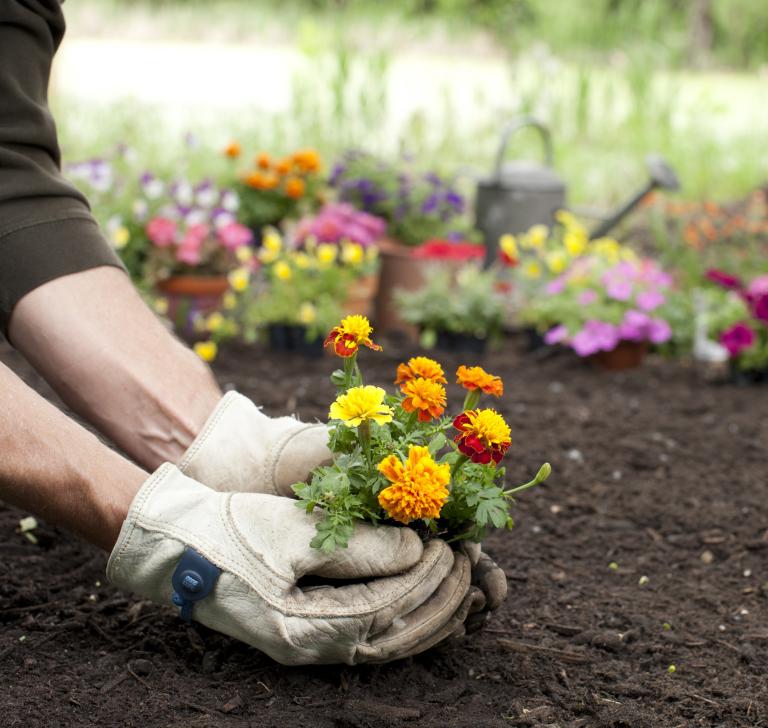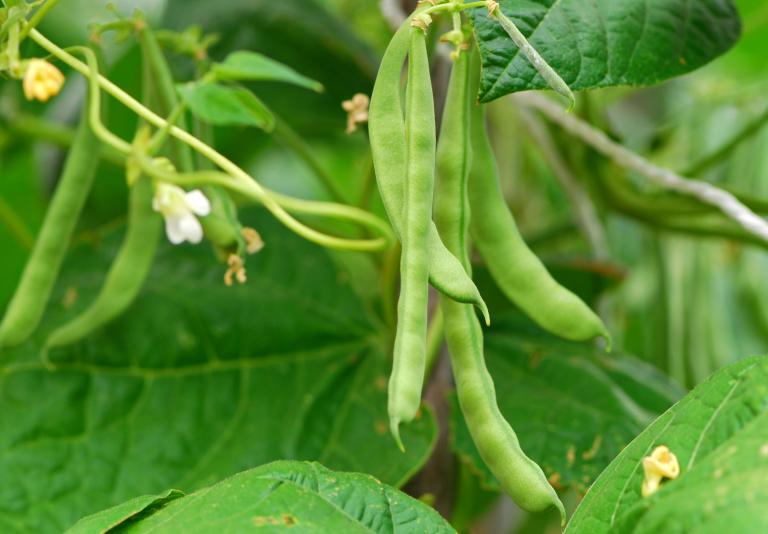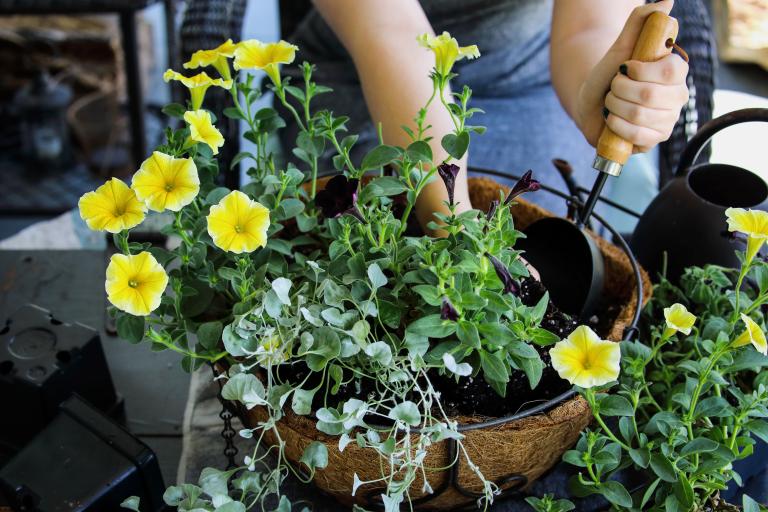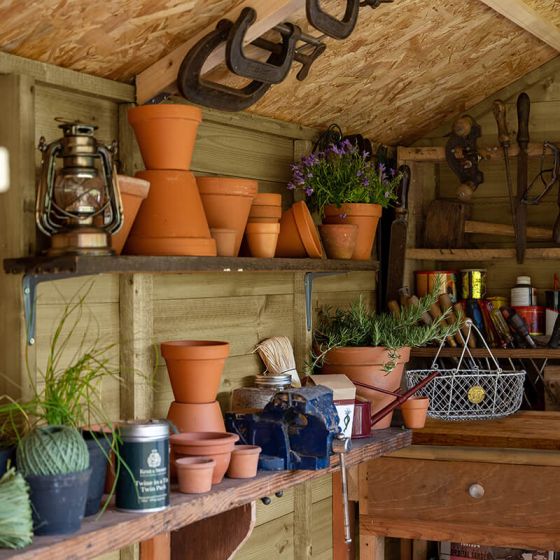May Hints & Tips
"May is a wonderful month in the garden, it’s the start of Summer or perhaps the end of Spring in what has seemed a long, grey and damp start to the year. However, the Spring blossom has been magnificent. Magnolias, Camellias and Cherry Blossom certainly brightened our gardens. May is the time where your garden will be full to bursting with new leaves in so many shades of green. Each day brings the welcome sight of new flowers opening and the garden looking young and fresh with everything growing at extra speed."
- Chris Milborne -

Things to do this month
If you have herbaceous, or cottage garden plants, in your borders make sure you are giving them a little help with a good feed of Vitax Q4 as they emerge. This is an excellent general-purpose feed that feeds for a long period. This is also the time to get some good sturdy, stylish plant supports above the taller growing varieties as it’s much easier if the plant grows up through these structures rather than trying to force them over the top once they have already grown too big. They make nice features in the garden as they wait to be filled up. If you have good clumps from previous years you can divide these now or it’s a great time to be planting new ones.
Add in to your borders clumps of summer flowering bulbs such as Gladioli, Agapanthus and Dahlias. Feed Daffodils and Tulips as they fade with Miracle Gro liquid feed and divide large clumps of snowdrops.
Early flowering shrubs, such as Spiraea Arguta Bridal Wreath, should be pruned immediately after flowering using a good sharp pair of secateurs, such as the Spear and Jackson traditional bypass secateurs, or some hedging shears, such as the Wilkinson Sword Razor Cut Pro hedge shear. Often just a good clip over to tidy them up is all that is needed. Whilst looking at your shrubs, look out for green shoots amongst the variegated varieties such as Eleagnus Pungens Maculata and remove them completely as these green shoots will be more vigorous than the more attractive variegated stems and spoil the look of the shrub.

We all love eating fresh runner beans but often don’t have the space to grow them. Well if you’ve got just 2 square feet spare on your patio, you could use a Haxnicks pea and bean patio planter, fill with Jacks Magic compost, some six foot canes neatly clipped at the top with a sweet pea and bean ring, and away you go! View our helpful grow your own guide, here.
As it’s been so chilly you might not have been able to give your lawn its spring feed of Evergreen complete 4 in 1 yet. If this is so and your lawn looks like it needs a tonic, you could give it a feed immediately with Miracle Gro water-soluble lawn food. The advantage to your grass is that these nutrients are available as soon as you water it on, giving an instantly improved appearance, whereas the granular feeds need to be washed in and dissolved.
Suppress weeds and retain moisture in the soil with a good thick layer of Bark mulch around your fruit trees. They do not like competition at the roots from other plants and weeds.

As the roses are now growing well, it’s essential to give a good feed of a proper rose food such as Toprose and begin a regular spraying program with Rose Clear Ultra to prevent greenfly, blackfly, blackspot and mildew becoming a problem later in the year.
With the grass growing more and mowing becoming more regular you might wish to compost all the clippings. If you have used a feed and weed, avoid putting the first cut in your compost bin but thereafter layer the grass in the bin, ideally mix with some coarser green waste and every six inches (15 cms) sprinkle on a layer of Garotta to speed up the composting process.
Finally, it’s getting close to the really good fun events of choosing the plants and filling your pots and hanging baskets with your summer bedding and patio plants. The ranges and colour combinations are endless but we’ve noticed that white flowers are a very strong trend this year. They could be planted up now and kept in a greenhouse for a couple of weeks until the danger of frost has passed before moving out to their permanent positions. Don’t forget to add Miracle Gro slow release fertiliser into the compost before planting and ideally use the Miracle Gro moisture control compost for best results.
If you have any gardening questions, click here to submit your query!
From the potting shed...

Our monthly gardening newsletter, written by our Great Amwell plant department colleague, Chris Milborne.
May is a wonderful month in the garden, it’s the start of Summer or perhaps the end of Spring in what has seemed a long, grey and damp start to the year. However, the Spring blossom has been magnificent. Magnolias, Camellias and Cherry Blossom certainly brightened our gardens. May is the time where your garden will be full to bursting with new leaves in so many shades of green. Each day brings the welcome sight of new flowers opening and the garden looking young and fresh with everything growing at extra speed.
The excitement and beauty of apple blossom; woodland bluebells making their colourful impact; Aquilegia, Allium, Geum and Dicentra (Bleeding Heart) filling the borders and Rhododendrons and Azaleas gradually coming into bloom. You also have the slightly scented Clematis montana in so many shades of pink and white covering fences, pergolas or even climbing through trees. Something new to look at every day.
It's also a very busy month with longer evenings and hopefully warmer brighter weather giving us the motivation and time to tidy up the Spring flowering plants and to choose wonderful, decorative summer plants for beds and borders. These will give you inspirational, colourful displays throughout the warmer months. Tubs, containers and hanging baskets can also be used to brighten literally any area. You can plant up Dahlias, Cosmos, Sunflowers, Sweet Peas and other Half Hardy annuals (just keep an eye on the weather for any late frosts). There a plenty of vegetables that you can sow, plant and grow too. Keep on top of the weeds so they don’t become a major problem.
May Plant highlights
Rhododendrons and Azaleas provide glorious displays. The name Rhododendron comes from the Greek ‘Rhodos’ meaning Rose and ‘dendron’ meaning Tree. It’s one of the oldest plant species having been in existence for approximately 55 million years and found in the wild across North America, Europe and Asia. They were first introduced to Britain in 1656. They come in a range of sizes with some developing into huge shrubs or trees, whilst others remain more compact. The flowers vary in colour (you can find them in white, pink, lavender, violet, purple, crimson, yellow, apricot and orange) and shape (funnel, tubular and bell shaped). They need a well-drained humus rich acidic soil; they prefer dappled shade but will grow quite happily in full sun too. Plant them in a bed with Japanese Acers or Pieris japonica ‘Variegata’. Both have foliage that will contrast with the leaves of the Rhododendron. Lower growing plants that could also be planted include Ferns, (eg Dryopteris Jurassic gold), Lily of the Valley, Lily henryi, Lily speciosum, Epimediums, Brunnera, Pulmonaria or the Hardy Geranium phaem.
If your soil conditions aren’t suitable then you can grow Rhododendrons or Azaleas in containers, using ericaceous compost. Feed regularly with an ericaceous feed and they prefer rain water to tap water. Try to keep the heat of the summer sun from the pots so the roots remain cool. I tend to have other pots in front of them to provide the shade. In these pots I plant Hosta’s for their foliage and Agapanthus for their stunning blue or white flowerheads.
There are even deciduous Rhododendron varieties available with striking flowers in yellow and orange shades and foliage that turns gold in Autumn before falling.
A popular early flowering climbing plant is Clematis montana. It’s very easy to grow with its four petalled, often scented, long lasting flower. It is available in many different colours. Prune this type of Clematis after flowering.
Alternatively, you can try an early flowering Honeysuckle. Lonicera p. ‘Belgica’ is a great variety with its fragrant yellow, white and reddish flowers, it will climb up trees, fencing and trellis. It needs a moist fertile soil; roots prefer to be in the shade. Honeysuckle can also be grown with other plants such as Hawthorn, Beech, Hornbeam, Climbing and Rambling roses plus evergreen shrubs such as Photinia, Aucuba or Laurel to create a mixed hedge.
Another easy to grow shrub that flowers May to June is Syringa (Lilac), the upright conical flowers are sweetly scented. Taller specimens such as ‘Michel Buchner’ or ‘Souvenir de Louis Spaeth’ make a fabulous feature plant. Dwarf varieties, for example ‘Red Pixie’ or ‘George Eastman’ can be planted in containers and look superb amongst other shrubs.
Wisteria is the ultimate early flowering climber. It’s a woody, twining plant native to China, Japan, Korea and Vietnam. The Japanese wisteria (Floribunda) twines clockwise whilst the Chinese varieties (Sinensis) twines anti-clockwise. These plants have grown in China for over two thousand years and were introduced to Europe in 1816. The blossoms are long clusters of pea-like flowers in white, lilac, pink or purple. The plant can be trained to cover walls, pergolas or gazebos. Alternatively, it can be trained up a post to make a weeping standard tree. Wisterias prefer full sun and fertile, moist, well-drained soil.
Other May shrub highlights include Choisya ‘White Dazzler’. A fragrant flowered, evergreen shrub with masses of white blooms. They’re a great pollen source for bees and other pollinators.
Berberis darwinii, Cytisus, Ribes, Viburnum also come into their own now. You could also try Sambucus ‘Black Lace’ or similar varieties that have glorious dark leaves which provide the perfect backdrop to clusters of pink flowers that give way to shiny black berries.
Perennials include Geum, Paeonia, Euphorbia, Iris, Pulmonaria, Tiarella or Allium are all perfect for filling gaps in the borders as Tulips finish and before other perennials and roses get started. These later perennials hide the foliage of the Alliums which dies down as the beautiful flowerheads start flowering. I have found that some larger flowering Allium dislike damp soil conditions in Summer and prefer to be lifted, dried off and stored in a warm position on trays wrapped in straw or just newspaper. This gives them a summer rest before being replanted in September.
Tubs and containers
Alpines or Rockery plants are perfect for containers. You can find an enormous variety in leaf shapes, texture and different coloured flowers, there’s bound to be something you like. Select a shallow container and for good drainage, mix in about 20% horticultural grit with a multipurpose compost or John Innes No.3.
Choose compact plants with a few trailing varieties to cascade over the edge. For a natural look plant Sempervivums (House leeks) at an angle so the foliage faces the sun and also helps protect this succulent from the rain. Easy to grow varieties include Armeria, Campanula, Dianthus (Pinks), Ajuga, Alpine Phlox, Primula, Saxifrage, Allysum saxatile and Helianthemum (Rock Rose). Once planted finish off with pieces of rock and a top dressing of gravel or slate chippings.
For a dazzling brilliant summer display, now is the time to plant up all your tubs, containers and hanging baskets. These plants will be growing and performing nonstop, until November, so always use new potting compost for maximum nutrition. Ideally mix the compost with Vitax Q4, this is a long-lasting slow-release fertilizer. It is easy to use, no need to measure as the plant uses the nutrient as required. There is such a choice available for customers these days and one of the best parts is actually choosing the plants. Everyone has their own colour preferences and planting styles. Personally, I like mixing colourful herbaceous perennials with summer bedding plants, or herbs, to give colour, flower and scent. I have also found that including white or very pale pink flowers against colours such as purple provides a great contrast, with the paler flowers really showing up in both the early morning and early evening light. Perhaps try a formal style either by using just one type of plant or planting in a single colour. Pelargoniums give a striking effect by using bright red, pink or orange varieties. Alternatively look at a pastel palate, using pinks, blues and mauves. For contrast try silver foliage or a hot mix with bright yellow, orange, reds and purples.
For a Mediterranean feel use tubs and containers planted up with Olives, Trachycarpus, or Citrus or try a mix of Lavenders, Rosemary & other herbs (e.g. thyme and oregano) that cascade over the edges. A mixture of Zonal Geraniums with the trailing Ivy leaf geraniums will also look great. With all containers, just remember to water and feed regularly. This, along with regular deadheading will give you months of summer appeal to brighten and transform any space. For maximum impact, group 3 containers together. If you use similar pots designs or colours this will work better than individual pots dotted about. For a more formal effect you could use topiary, we have many options available.
Plant up hanging baskets using a mix of bushy and trailing plants with something taller in the middle, often referred to as a ‘Dot’ plant. We have an unrivalled range of pack and potted bedding plants and staff are always available to help when you are deciding colours and type of plants.
Other jobs for May
Now is the time to provide plant supports especially for Delphiniums, Lupins and Paeonia, using twigs, or I use old Cornus stems from late winter pruning, but wire grids with interlocking metal supports, trumpet shaped or circular plant supports in black or a natural rust colour are also available and can be reused, year after year.
Tie in climbing roses, laying the stems horizontally against supports on your fencing, trellis or walls. This will help produce flower buds along the whole stem rather than just the tips.
Plant out Sweet Peas. These come in so many gorgeous colours, many of them are highly scented and they great as cut flowers later on. Always cut or deadhead to keep them constantly flowering throughout the season.
Prune back late summer flowering plants by a third. Examples of plants that will benefit from this are Echinacea’s, Helenium’s, Phlox, Coreopsis and Sedums. Although this technique delays flowering, it makes the plants much bushier & stronger. It’s commonly known as the Chelsea chop, as the best time to do it coincides with the RHS Chelsea flower show.
To attract bees, butterflies and other pollinators into the garden think about Shrub roses, Buddleia, Lavender, Ceanothus, Lilac, Cotoneasters, Foxgloves, Polemonium, Bergenia, Hardy Geraniums, Centaurea, Scabious, Aster, Sedum, Geum, Marigold, Marjoram Or Thyme. All beautiful to look at and all also helping our wildlife too.
Vegetables and Herbs
May in the vegetable area is all about sowing and planting. Regular weeding helps prevent weeds from spreading and seeding themselves. Sow Beetroot, Swede, Carrot, Cabbage, Radish, Swiss chard, Turnips, Peas Spring Onions, Lettuce Rocket or Beans. With some plants, like Lettuce, Rocket, Radish or Coriander-sow little and often, perhaps every two weeks for good consistent cropping.
The frost prone vegetables such as Runner Beans and French beans are best started off in a cold frame. When it’s time for planting, the plants are well established and less prone to slug and snail damage too. However, you can sow directly outside. For the best results a sunny position and well manured, free draining soil will always give the best outcome.
Sweetcorn are best grown in blocks rather than rows as the plants are wind pollinated. I have found for the best results you need to grow 24 plants, spaced 45cm (18in) apart or if growing from seed, sow 3 or 4 seeds 5mm (1/4in) deep. Once germinated remove the weakest seedlings.
Squash, Marrow, Courgette and Pumpkin all need rich moist soil. If growing them in the soil, dig a pit 30cm (12in) wide and deep, fill with well-rotted garden compost or bagged farmyard manure, cover with top soil making a mound 15cm (6in) high in the middle. Plant or sow on top of this, when actively growing the roots go down into the rich moist soil, whilst water soaks away from the main stem so it doesn’t rot.
Plant out Tomato, Pepper and Cucumber, as soon as nighttime temperatures are consistently above 10 degrees at night and 12 degrees during the day.
Earth up potatoes.
Potato plants are traditionally 'earthed up', which means mounding up soil around the stems as they grow. This protects the shoots from frost damage in late spring and ensures the developing potatoes aren't exposed to light, which turns them green and inedible.
Many vegetables make attractive displays when grown in containers on the patio, try the Swiss Chard, Beetroot and various lettuces for their colourful leaves. Create a herb hanging basket as an interesting alternative to bedding plants. Favorites to try include Scented leaf geraniums, Parsley, Purple Sage, Mint, Oregano, Marjoram, Thyme, Prostrate Rosemary and for flowers, Borage, Trailing Nasturtium or Marigold. We have a wide range of vegetables and herbs available in both trays and pots, ready to be planted out.
Hints & tips
Take photographs of your garden, as your plants unfurl and grow this makes a good reference point for next year and will help with new ideas.
Check Lily and Fritillaria plants for the scarlet lily beetle and their larvae as they will rapidly strip foliage from plants.
Grow tulips in 30cm (12in) pots sunk into the ground then when they’ve finished flowering lift out and replace with pots of Dahlia or Zonal Geranium, placed in the same hole for instant extra interest in a mixed border.
Protect strawberries from birds.
Feed established lawns, if you didn’t do it in April.
Plant pollinator friendly perennials into gaps in your beds and borders.
The recent rainfall has compacted the soil forming a solid crust. Hoe or rake this to break it up and cover with an organic mulch.
With the warmer weather approaching, now is a good time to deal with any bare patches in your lawn. Sow seed, and it should germinate in 7-10 days. Or lay Turf, please check on Turf availability first, if you are making a special journey for this.
Most importantly, take time to enjoy your garden.


